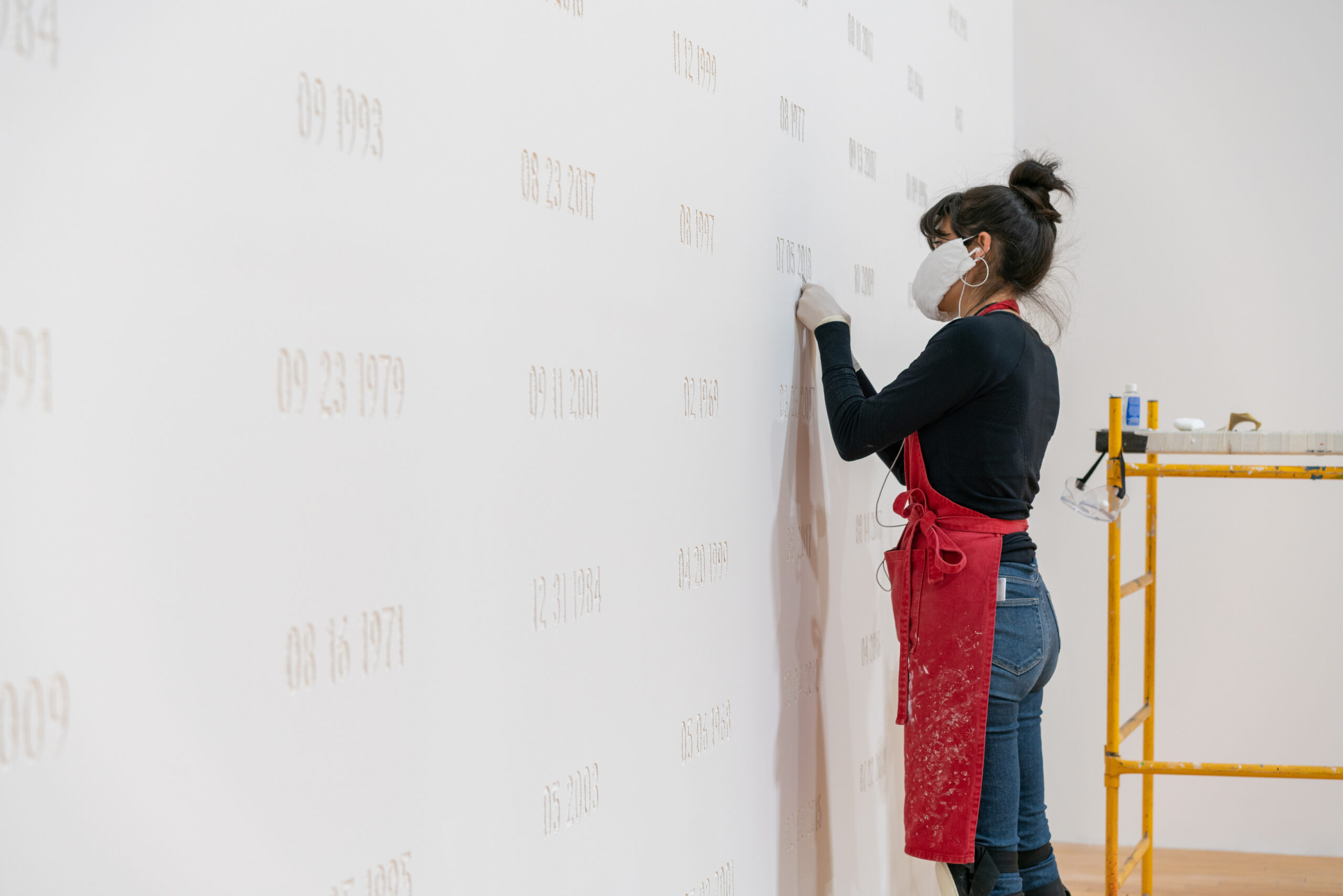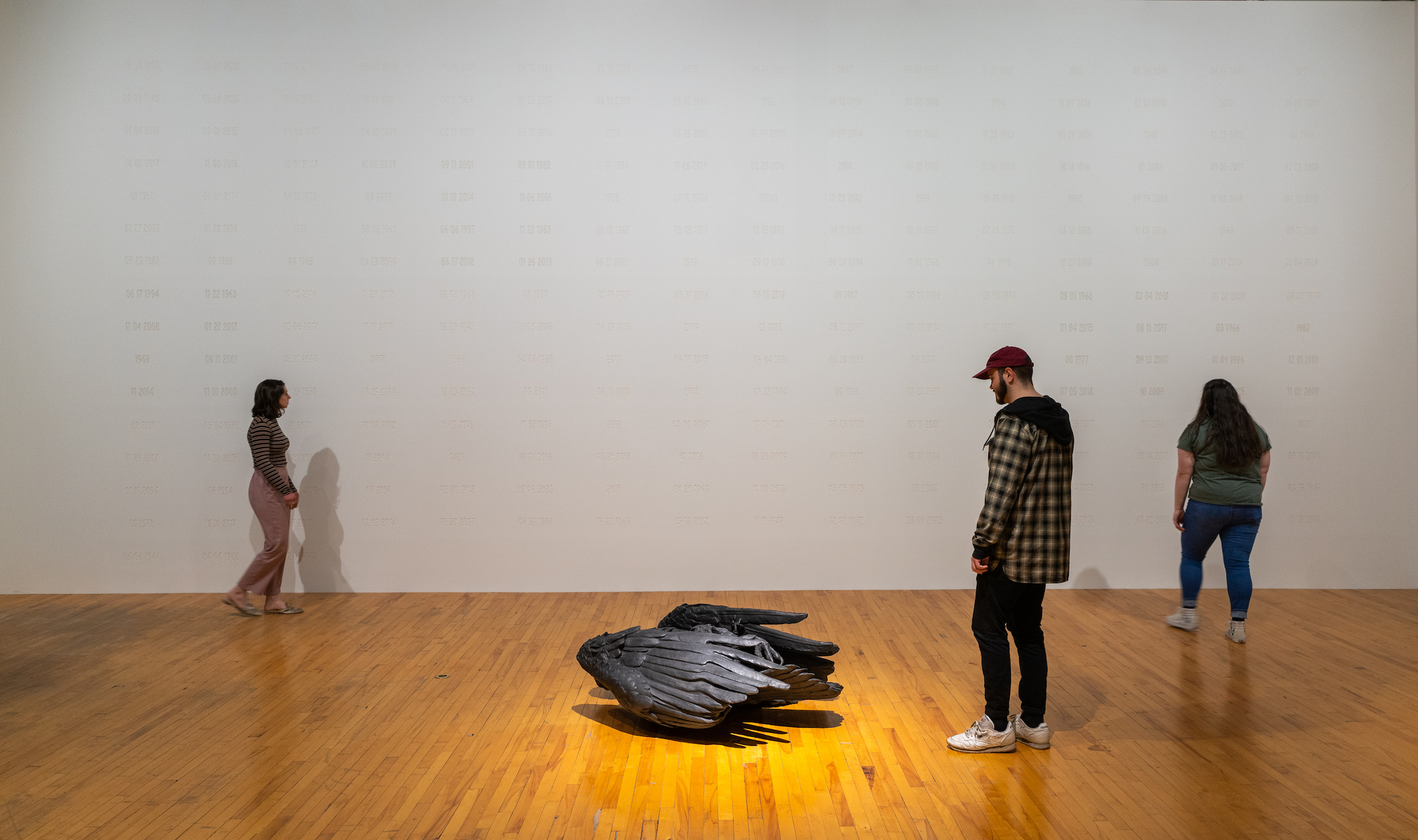By: Judy Nyquist and Laura Worth
Born in El Paso, TX, artist Adriana Corral has established herself as an artist with a very powerful voice, rooting her message in well-researched topics, and speaking to issues of human rights abuses, memory, loss, and erased historical narratives. While she has traveled, studied, and worked all over the world, Texas is Corral’s home, and with poignant and compelling immediacy, she brings to light many complex and difficult contemporary issues. Adriana’s practice is based on diligent research. She seeks out human rights attorneys, city officials, policymakers, historians, authors, journalists, professors, scholars, and more, who can all inform her work. Recently relocated to Houston, Adriana is looking forward to engaging with our community, and GHWCC’s network of strong, influential women. We invite you to read her interview and encourage the work she is doing here and worldwide.
“…it is my hope to create spaces or works that generate conversations from the very themes I work from.”

Adriana Corral working on the installation of Requiem, 2019, dates hand-carved into drywall, Dimensions variable, Courtesy of the artist
Adriana Corral Q & A:
What are some things about Houston that have inspired you, and helped develop you as an artist?
Moving to Houston with my fiancé Vincent Valdez has been transforming for both of us. It is wonderful to be in a city that is globally recognized for its art institutions—from museums, galleries and other artistic programs like the ballet, opera and symphony—all which provide inspiration. Since being in Houston, individuals such as Betty Moody and Michael Ray Charles have been enormously supportive in exhibiting and sharing my work to larger audiences, visiting curators and seeking out national grants.
How does your voice as a woman influence your projects, informing which ones you choose to do, the subject matter, etc?
I was fortunate to grow up in a family with fierce and influential women. They modeled an incredible work ethic, strength, and genuine commitment to empowering women of all ages. This sense of attentiveness has shaped the woman I am and strive to always be. They also brought to my attention different forms of violence against women, injustices that extend to minorities or those marginalized, as well as challenges I may experience as a woman in the workforce. In many ways these beacons have impacted the decisions and work I create —from historical narratives to human rights for women and marginalized individuals.
What are some of your dream projects or goals as an artist?
I know first-hand the impact a scholarship can have in accessing higher education and one day I would like to have the means to create a scholarship for young aspiring artists and art historians so that they could pursue projects that would impact their communities positively. I also dream of creating a research center that would facilitate multidisciplinary collaboration and connect individuals—community members, physicians, public health officials, architects, and historians (to name a few)—with artists. The center would formalize the kind of collaborative research environment that I began to create for myself while I was in graduate school at the University of Texas at Austin. I am currently building a similar network of collaborators here in Houston to address my new body of work focused on delousing practices used on immigrants in the early part of the 20th century.
What is your process like when you begin a project? Do you work with a team, listen to music, juggle several projects at once – what works for you?
I carefully plan the different phases of research and development, while jointly being intuitively guided. My research-based practice requires sensitivity to the content and space where the artwork is conceived, and throughout the development phase of each new body of work, at times I collaborate with journalists, families of victims of violence, artists, scholars, historians, and human rights attorneys. The collaborations contribute a vital layer—the ability to bridge relationships within various disciplines, communities, demographics, and ages.
Some of the main elements of my work are text, the act of erasure, and the materials of soil and ash. When I begin creating a work, I pay attention to these elements, and work to create a conversation between them. Depending on the intention behind the work, it is my hope to create spaces or works that generate conversations from the very themes I work from.
My studio comparatively feels like a greenhouse, where I have multiple ideas cultivating. Many of my projects are years in development. I am constantly nurturing each “seedling” or work in such a way that oftentimes they end up informing or building off of each other.
Many of your projects are site-specific; how do you go about documenting and cataloging the work?
One of my touchstones when creating installations is referring back to places in my life that have granted me moments of contemplation. At various times when I lived in Europe, it was the duomos in Italy and monuments and memorials throughout Germany and Poland that resonated with me most. Spending time in sacred spaces I observe how life is honored and how individuals occupy them in various capacities. I base my installations on existing architecture, specifics of the place, and patterns of use. Achieving a balance between the content, space and those whose narratives I aim to honor is something that is always evolving.
Many of my site-specific works breathe in a new way every time they are installed. The cyclical process of revival and deinstallation that often accompanies these works is an important part of the process and documenting it. Once the exhibition is deinstalled the names or documents (Memento and Campo Algodón, Cuidad Juarez, 21 de Febrero del 2007) transferred onto the wall will be painted over, but still forever embedded in that wall. I request the museum or institution to pack and mail the ashes to me. The archived ashes document the dates of installation, where, when and who was involved.
 Bronze and ash…Courtesy of the artists and David Shelton Gallery, Houston, TX
Bronze and ash…Courtesy of the artists and David Shelton Gallery, Houston, TX
It is my intention to always keep a record of my own work in a way that runs counter to the hidden nature of the histories my work exposes and questions.
Any hints/previews you want to give our audience of what you are working on now? [Take of leave] How has covid influenced (or not) your message?
My latest project aims to highlight the transnational relationship in the delousing procedures in 1917 used on Mexican immigrants along the US/Mexico border. Very little information about 20th-century delousing procedures using an assortment of cyanide-based chemicals (Kerosene, Zyklon B, and DDT) is available to the broad public. David Dorado Romo, PhD has revealed an enormous amount of this history in his book, Ringside seat to a Revolution. He has been an incredible resource as I continue to research these treatments.
In David’s book, he highlights a significant moment when 17-year-old Carmelita Torres protested the bath and delousing process at the Santa Fe International Bridge (El Paso/Juarez). The “Bath Riot” began with Carmelita and then quickly grew to thousands of women joining her in protest. It was described as “bees swarming” and the result of the protest shut down the bridge for three days. The women were not only protesting the delousing, but it was reported that men were photographing them unknowingly during the bathing process and circulating the images. Many letters were sent to the Surgeon general reporting this activity. Unfortunately, the delousing process did not yield but would go on for another 40 years.
PHOTO CREDITS
Adriana Corral & Vincent Valdez, Requiem, 2016-2019, site-specific installation, dates hand carved into drywall, bronze and ash.
Images courtesy of MASS MoCA
Sous Rature, ‘Under Erasure,’ 2016, site-specific installation, Universal Declaration of Human Rights recreated in soil and ash, steel, bullet-resistant glass, and 4x8x6ft burial plot.
Originally commissioned and produced by Artpace, San Antonio. Photo by Adam Schreiber.
Unearthed: Desenterrado, 2018-2019, site-specific installation at the historical Rio Vista Farm, 60ft stainless steel flagpole, 18ft X 30ft embroidered golden and bald eagle on white cotton flag.
Produced and Curated by Black Cube
Images courtesy of Adriana Corral
